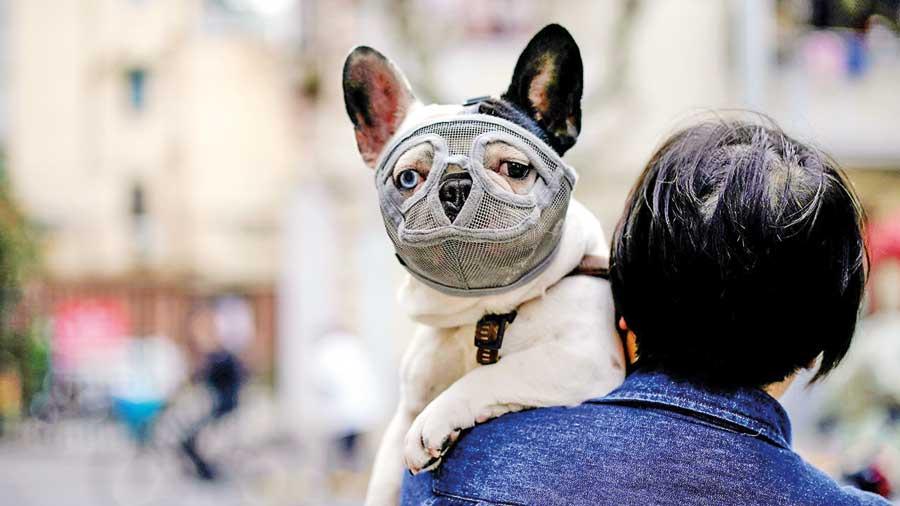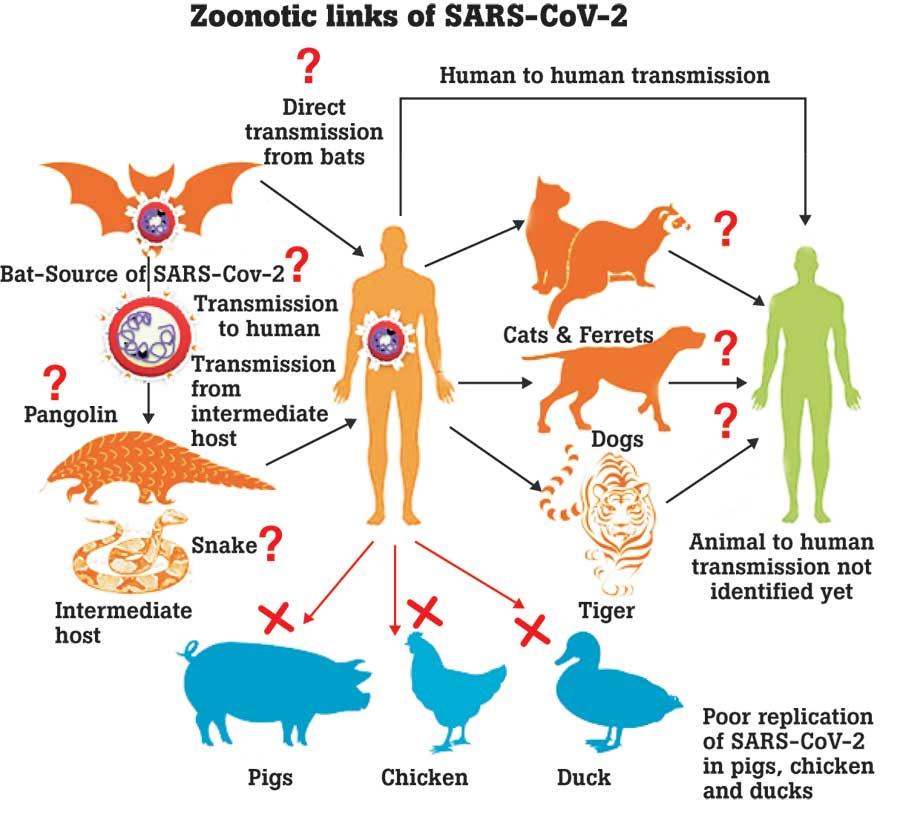Reply To:
Name - Reply Comment
Last Updated : 2024-04-25 15:57:00
Coronavirus: Zoonotic Origin and Susceptibility of Domestic and Wild Animals

Animal Coronaviruses have been known since the late 1930s and human pathogenic Coronaviruses were first discovered in humans in the mid-sixties. Before the first isolation of two strains of Coronaviruses from the nasal discharge of patients who had contracted the common cold, a diverse range of Coronaviruses had been isolated in various infected animals, including turkey, mouse, cow, pig, cat, and dog. Coronaviruses are contributing to the common cold and a range of animal and avian coronaviruses, such as infectious bronchitis virus (IBV), which infects poultry. Coronaviruses characteristically cause respiratory or gastrointestinal infection; however, strains of poultry Coronaviruses (IBV) have been shown to target the oviduct in chickens, and others can cause severe kidney disease. Some Coronaviruses (CoV) are zoonotic (transmitted from animals to humans).
first discovered in humans in the mid-sixties. Before the first isolation of two strains of Coronaviruses from the nasal discharge of patients who had contracted the common cold, a diverse range of Coronaviruses had been isolated in various infected animals, including turkey, mouse, cow, pig, cat, and dog. Coronaviruses are contributing to the common cold and a range of animal and avian coronaviruses, such as infectious bronchitis virus (IBV), which infects poultry. Coronaviruses characteristically cause respiratory or gastrointestinal infection; however, strains of poultry Coronaviruses (IBV) have been shown to target the oviduct in chickens, and others can cause severe kidney disease. Some Coronaviruses (CoV) are zoonotic (transmitted from animals to humans).
Why are they called Coronaviruses?
Some suggest that the name Coronavirus spike protein around the lipid envelope of the virus gives a characteristic ‘crown’ shape to the virion (a complete virus particle, comprising of an outer protein shell called a capsid and an inner core of nucleic acid either ribonucleic or deoxyribonucleic acid— RNA or DNA ), resulting virus is named as Coronavirus.
However, as the journal Nature have reported in 1968, “these viruses are members of a previously unrecognized group, hence the virologists suggested that they should be called the coronaviruses, to recall the characteristic appearance by which these viruses are identified in the electron microscope.
“The word “corona” has diverse meanings. But it was believed to be the sun that the virologists had in mind when they opted for the name coronaviruses. As they wrote, they compared “the characteristic ‘fringe’ of projections” on the outside of the virus with the solar corona (not about, the points on a crown).
There are seven coronaviruses that infect humans, SARS-CoV-2 (Covid-19) is considered the seventh Coronavirus that infects humans. And SARS-CoV and MERS-CoV are other zoonotic Coronavirus diseases that have resulted in high mortality outbreaks in the last two decades.
However, the other coronaviruses are usually associated with mild upper-respiratory tract illnesses, like the common cold and occasionally may cause complicated disease in immune-compromised (weak) individuals.
Human infective first Coronavirus strain was isolated from the nasal discharge of patients with the common cold in the mid-nineteen sixties. Since then, more knowledge was accumulated through extensive studies on human pathogenic two coronaviruses both of which causes self-limiting symptoms.
Undeniably, the notion had been widely accepted that infection with human Coronaviruses is generally harmless until the outbreak of Severe Acute Respiratory Syndrome (SARS) outbreak occurred in 2003. The SARS outbreak is one of the most dreadful in the recent past, infecting over 8,000 people with a crude case fatality of approximately10%. Ten years later, the Middle East Respiratory Syndrome (MERS) outbreak resulted in a persistent epidemic in the Arabian Peninsula with sporadic spreading to the rest of the world.
The Coronavirus manifestation in humans differs from mild flu-like symptoms to fatal signs as seen during the Severe Acute Respiratory Syndrome (SARS), Middle East Respiratory Syndrome, (MERS), and Covid-19 outbreaks in humans.
The SARS-CoV-2 is the causative agent of the ongoing epidemic of Coronavirus disease 2019 (COVID-19) with worldwide confirmed cases of 108,102,621 and claimed 2,396,309 lives as of February 21, 2021.
Coronaviruses that affect the cats cause the respiratory tract, central nervous system, abdominal cavity, and gastrointestinal tract to produce enteritis and infectious peritonitis
Origin of Zoonotic SARS-CoV and Covid-19
The disease called Severe Acute Respiratory Syndrome (SARS), caused by the virus SARS-CoV, first reported in 2002 in China and spread to 29 countries as a global threat within a short period.
The incidence of SARS demonstrated the slow emergence of coronaviruses from animal hosts with possibly fatal diseases in humans. The origin of SARS-CoV was considered to be from bats, although it needs further evidence to prove as actual host, similarly, the palm civet cats from the wet markets of Guangdong China, was supposed to be the intermediate host.
The Coronavirus-infected bats usually remain asymptomatic. The Middle East Respiratory Syndrome (MERS) is another fatal Coronavirus that affected humans; it is caused by a MERS-CoV, which occur due to contact with camels or camel products and is endemic in the Middle East.
However, among all Coronaviruses of humans, the ongoing outbreaks due to SARS-CoV-2 have higher virulence and, in a short period caused the global pandemic and created a significant threat to public health. The emergence of the Covid-19 narrates the use of wild animal meat in Wuhan, China. The epidemiological evidence indicates that zoonotic transmission of COVID-19 has occurred in Wuhan’s Seafood Wholesale Market through the trade of wild animals.
Molecular analysis exhibited that the virus has a higher similarity with a horseshoe bat Coronavirus obtained from Yunnan Province. Recently scientists have isolated many Coronavirus strains in bats throughout the Asian region. Bat-viruses can rarely infect humans directly. Thus, there has to be another host involved transmission of Covid-19. Some evidence indicating that pangolins could have transmitted infection to humans.
Further, some argue that Bamboo Rats and Civets could be the intermediate host. The SARS-CoV-2 (Covid-19) obtained from the Chinese Wuhan market supports the persistence of the virus through a live animal source; however, the likely Covid-19 intermediate host has not been ascertained thus far.
In dogs, Coronaviruses cause intestinal and respiratory tracts infections, while in the poultry industry, a disease called infectious bronchitis caused by Coronavirus (IBV), cause extensive economic loss by producing respiratory illness, urinary tract infection, and reproductive problems
Hosts for Coronaviruses
Coronaviruses (CoVs) infect humans, as well as domestic and wild animal species and typically infections, endure sub-clinical in most cases.
The clinical form varies from enteritis in cattle, horses and swine, upper respiratory tract disease in cattle, dogs, felines, and poultry, and the common cold to highly fatal respiratory infections in humans.
Zoonotic pathogens like SARS-CoV and MERS-CoV which have bats as primary hosts and palm civet cat and dromedary camels as intermediate hosts, respectively. And many Coronaviruses have been recovered from birds and pigs as well.
It has been established that cattle, horses, swine, dogs, cats, camels, rabbits, rodents, birds, ferrets, mink, bats, snake (such as Chinese cobra and krait), frogs, marmots, hedgehogs, Javan or Sunda pangolin harbouring Coronaviruses that may or may not cause clinical symptoms. Under this backdrop WHO has emphasized the need for further research to ascertain animals’ role as carrier/reservoir.
In pigs, acute diarrhoea syndrome Coronavirus produces severe enteritis in suckling piglets, causing significant mortality. Genomic studies suggested that there is the possibility of host jumping by a Coronavirus from bats to pigs by crossing the species barrier
Zoonotic links of Coronaviruses
It has been proven that coronaviruses have a broad animal host range, several animal species harbour these pathogens, but only a few of them get a severe infection.
Among large animals, bovine coronaviruses have zoonotic potential as being isolated from asymptomatic children and also found affecting several domestic and wild ruminants, in which calf-diarrhoea in neonates, bloody diarrhoea in adult cattle and respiratory form of shipping fever in all age groups of cattle are worldwide occurrences.
Coronaviruses that affect the cats cause the respiratory tract, central nervous system, abdominal cavity, and gastrointestinal tract to produce enteritis and infectious peritonitis.
In dogs, Coronaviruses cause intestinal and respiratory tracts infections, while in the poultry industry, a disease called infectious bronchitis caused by Coronavirus (IBV), cause extensive economic loss by producing respiratory illness, urinary tract infection, and reproductive problems.
In pigs, acute diarrhoea syndrome Coronavirus produces severe enteritis in suckling piglets, causing significant mortality. Genomic studies suggested that there is the possibility of host jumping by a Coronavirus from bats to pigs by crossing the species barrier.

Zoonotic links of SARS-CoV-2)
What Animals Can Get and Spread COVID-19?
There have been reports that an insignificant number of animals have contracted Covid-19 from humans.
All of these pet animals and zoo animals have been reported to be infected by sick owners or zookeepers. Experimental research has demonstrated that cats, dogs, ferrets, fruit bats, hamsters, and tree shrews can develop covid-19. Amongst animals’ cats, ferrets, fruit bats, and hamsters appear to spread the infection to other animals of the same species in experimental (laboratory) settings. This has not proven in real environmental settings. Similarly, in experimental studies, it has been suggested that dogs can get affected but might not transmit the virus to other dogs as observed in cats and ferrets that spread the virus to other animals of the same species.
Several studies have investigated non-human primates as models for human infection. In all those studies established that Rhesus macaques, Cynomolgus macaques, grivets, and common marmosets can get Covid-19 in a laboratory setting.
However, laboratory mice, pigs, chickens, and ducks do not seem to become infected under experimental studies. It must be stated that, as of today, there is no evidence that animals play a significant role in the spread of Covid-19 to people.
Scientific findings, published in the journal PLOS Computational Biology, stated that ducks, rats, mice, pigs, and chickens had lower or no susceptibility to the Coronavirus compared to humans. However, cats, ferrets, civets, and dogs have documented cases of the Covid-19 virus infection.
"The emergence of Covid-19 narrates the use of wild animal meat in Wuhan, China. The epidemiological evidence indicates that zoonotic transmission of COVID-19 has occurred in Wuhan’s Seafood Wholesale
Market through the trade of wild animals"
“Identifying which animals are vulnerable to Covid-19 helps us to avoid building up animal reservoirs from which the coronavirus can re-emerge at a later date,” Hence, findings of genomic studies and experimental laboratory research on the susceptibility of different animal species to Covid-19 would help us in disease control measures.
News accounts early in the pandemic found cases of dogs and domestic cats contracting the virus. Early in the outbreak of Covid-19, some mink (ferret-like animals bred for their fur) contracted the virus on farms in Spain and Denmark.
Subsequently, covid-19 outbreaks in Mink farms were reported in Netherland, Sweden, the USA, Italy, Canada, Poland, Greece, and Lithuania. These seem to involve most of the significant disease activity among animals observed so far.

Animal Species Susceptibility for Covid- 19)
Pets and Covid-19
According to research findings, dogs may catch Coronavirus, but it is extremely rare. Domestic cats may also contract the virus a little easier than dogs, but still not as easily as humans and great apes.
Chinese hamsters, a popular pet variety, are among more highly susceptible animals. Cattle and sheep also have a “medium” chance of catching coronavirus, while horses and pigs have a low risk. Many of these animals, if infected, will not succumb to the disease – many may show no symptoms.
Animal outbreaks of COVID-19 are theoretical at this point. And no major clusters of the disease among animal populations or contracted from domestic animals are recorded. But that does not mean you should not be cautious with your dogs and cats.
Although pets like household cats and hamsters do not naturally get exposed to outside pathogens, humans who are infected (sickened or who are asymptomatic carriers) of the disease can easily spread it to vulnerable indoor pets. According to the Center for Disease Control (CDC) of the USA, dogs can get infected, but might not spread the virus to other dogs easily. Cats and ferrets, however, can easily spread the virus to other animals of the same species.
Fundamentally, pets can get the disease if they are exposed (if you have the disease), so you must make sure you keep away from them and wear a mask even when you are at home.
It is well proven that transfer from person to person is inside a congested area with people, suggesting isolating your pets indoors could be counterproductive.
So, it would be more concerned about the pet contracting the virus inside the home. Thus, ensuring your home is well ventilated is a particularly a good preventive measure. And treat your pet as you would treat one of your friends; always keep your hands washed and wear your mask around them if you are suspecting that you may be transmitting the virus. If you are going out for a walk with your dog, practise social distancing, it is now well known that it is more difficult for dogs to contract the disease than humans.
If you can keep your dog leashed and away from other dogs and people, in other words, if you practice a simple preventive measure like social distancing, “you and your pet will be secure.” Finally, it is prudent to say that research findings have not documented cases of Covid-19 transmission from pet animals to humans;“ the main source of infections for humans is other humans.”
The author, Mohamed Ijas (BVSc, MBA, PG-Dip, MSc) is the Municipal Veterinary Surgeon of the Colombo Municipal Council. He can be reached via mohivs@yahoo.com

Add comment
Comments will be edited (grammar, spelling and slang) and authorized at the discretion of Daily Mirror online. The website also has the right not to publish selected comments.
Reply To:
Name - Reply Comment
US authorities are currently reviewing the manifest of every cargo aboard MV
On March 26, a couple arriving from Thailand was arrested with 88 live animal
According to villagers from Naula-Moragolla out of 105 families 80 can afford
Is the situation in Sri Lanka so grim that locals harbour hope that they coul